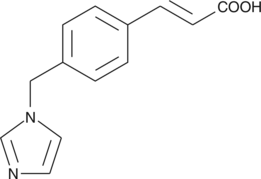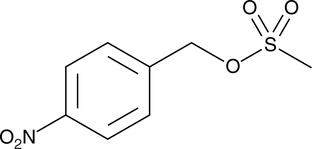Cayman
Showing 33601–33750 of 45550 results
-
Inhibition of thromboxane synthase (TXAS), especially in human platelets, has been a clinical objective for many years. 1-Alkyl (N-alkyl)-imidazole derivatives have been recognized as TXAS inhibitors since the early 1980s.{10335,10334,10336} Ozagrel is a 1-alkyl imidazole derivative that acts as a selective inhibitor of TXAS with an IC50 of 11 nM. The beneficial effects of TXAS inhibition by ozagrel include improved motor coordination after experimental stroke,{10146} and antihypertensive effects in spontaneously hypertensive rats.{10337}
Brand:CaymanSKU:70515 - 100 mgAvailable on backorder
Inhibition of thromboxane synthase (TXAS), especially in human platelets, has been a clinical objective for many years. 1-Alkyl (N-alkyl)-imidazole derivatives have been recognized as TXAS inhibitors since the early 1980s.{10335,10334,10336} Ozagrel is a 1-alkyl imidazole derivative that acts as a selective inhibitor of TXAS with an IC50 of 11 nM. The beneficial effects of TXAS inhibition by ozagrel include improved motor coordination after experimental stroke,{10146} and antihypertensive effects in spontaneously hypertensive rats.{10337}
Brand:CaymanSKU:70515 - 5 mgAvailable on backorder
Inhibition of thromboxane synthase (TXAS), especially in human platelets, has been a clinical objective for many years. 1-Alkyl (N-alkyl)-imidazole derivatives have been recognized as TXAS inhibitors since the early 1980s.{10335,10334,10336} Ozagrel is a 1-alkyl imidazole derivative that acts as a selective inhibitor of TXAS with an IC50 of 11 nM. The beneficial effects of TXAS inhibition by ozagrel include improved motor coordination after experimental stroke,{10146} and antihypertensive effects in spontaneously hypertensive rats.{10337}
Brand:CaymanSKU:70515 - 50 mgAvailable on backorder
Ozanimod is a selective, orally available modulator of the sphingosine-1-phosphate (S1P) receptors S1P1 and SIP5.{32048,32049} It induces internalization of S1P1, decreases circulating B and CCR7(+) T lymphocytes, and reduces inflammation and disease parameters in three autoimmune disease models.{32048} Ozanimod is in clinical trials for relapsing multiple sclerosis and ulcerative colitis.{32048,32047}
Brand:CaymanSKU:19922 -Available on backorder
Ozanimod is a selective, orally available modulator of the sphingosine-1-phosphate (S1P) receptors S1P1 and SIP5.{32048,32049} It induces internalization of S1P1, decreases circulating B and CCR7(+) T lymphocytes, and reduces inflammation and disease parameters in three autoimmune disease models.{32048} Ozanimod is in clinical trials for relapsing multiple sclerosis and ulcerative colitis.{32048,32047}
Brand:CaymanSKU:19922 -Available on backorder
Ozanimod is a selective, orally available modulator of the sphingosine-1-phosphate (S1P) receptors S1P1 and SIP5.{32048,32049} It induces internalization of S1P1, decreases circulating B and CCR7(+) T lymphocytes, and reduces inflammation and disease parameters in three autoimmune disease models.{32048} Ozanimod is in clinical trials for relapsing multiple sclerosis and ulcerative colitis.{32048,32047}
Brand:CaymanSKU:19922 -Available on backorder
Ozanimod is a selective, orally available modulator of the sphingosine-1-phosphate (S1P) receptors S1P1 and SIP5.{32048,32049} It induces internalization of S1P1, decreases circulating B and CCR7(+) T lymphocytes, and reduces inflammation and disease parameters in three autoimmune disease models.{32048} Ozanimod is in clinical trials for relapsing multiple sclerosis and ulcerative colitis.{32048,32047}
Brand:CaymanSKU:19922 -Available on backorder
p-APMSF is an irreversible inhibitor of serine proteases with Ki values of 1.02, 1.18, 1.5, and 1.54 µM for bovine trypsin, human thrombin, bovine plasmin, and bovine Factor Xa, respectively.{25670} It is selective for these proteases over bovine chymotrypsin and acetylcholinesterase.
Brand:CaymanSKU:-p-APMSF is an irreversible inhibitor of serine proteases with Ki values of 1.02, 1.18, 1.5, and 1.54 µM for bovine trypsin, human thrombin, bovine plasmin, and bovine Factor Xa, respectively.{25670} It is selective for these proteases over bovine chymotrypsin and acetylcholinesterase.
Brand:CaymanSKU:-p-APMSF is an irreversible inhibitor of serine proteases with Ki values of 1.02, 1.18, 1.5, and 1.54 µM for bovine trypsin, human thrombin, bovine plasmin, and bovine Factor Xa, respectively.{25670} It is selective for these proteases over bovine chymotrypsin and acetylcholinesterase.
Brand:CaymanSKU:-p-APMSF is an irreversible inhibitor of serine proteases with Ki values of 1.02, 1.18, 1.5, and 1.54 µM for bovine trypsin, human thrombin, bovine plasmin, and bovine Factor Xa, respectively.{25670} It is selective for these proteases over bovine chymotrypsin and acetylcholinesterase.
Brand:CaymanSKU:-p-chloro Phenylalanine is an inhibitor of tryptophan hydroxylase (Ki = 300 µM).{47198} It acts as a competitive inhibitor in vitro and an irreversible inhibitor in vivo. It depletes serotonin to undetectable levels in rats after six days when administered at a dose of 300 mg/kg. p-chloro Phenylalanine has commonly been used to deplete brain serotonin levels in animal studies of the serotonergic system and its involvement in depressive-like behavior, reward learning, Parkinson’s disease, and pain.{47199,47200,47201,47202}
Brand:CaymanSKU:26168 - 10 gAvailable on backorder
p-chloro Phenylalanine is an inhibitor of tryptophan hydroxylase (Ki = 300 µM).{47198} It acts as a competitive inhibitor in vitro and an irreversible inhibitor in vivo. It depletes serotonin to undetectable levels in rats after six days when administered at a dose of 300 mg/kg. p-chloro Phenylalanine has commonly been used to deplete brain serotonin levels in animal studies of the serotonergic system and its involvement in depressive-like behavior, reward learning, Parkinson’s disease, and pain.{47199,47200,47201,47202}
Brand:CaymanSKU:26168 - 100 gAvailable on backorder
p-chloro Phenylalanine is an inhibitor of tryptophan hydroxylase (Ki = 300 µM).{47198} It acts as a competitive inhibitor in vitro and an irreversible inhibitor in vivo. It depletes serotonin to undetectable levels in rats after six days when administered at a dose of 300 mg/kg. p-chloro Phenylalanine has commonly been used to deplete brain serotonin levels in animal studies of the serotonergic system and its involvement in depressive-like behavior, reward learning, Parkinson’s disease, and pain.{47199,47200,47201,47202}
Brand:CaymanSKU:26168 - 25 gAvailable on backorder
p-chloro Phenylalanine is an inhibitor of tryptophan hydroxylase (Ki = 300 µM).{47198} It acts as a competitive inhibitor in vitro and an irreversible inhibitor in vivo. It depletes serotonin to undetectable levels in rats after six days when administered at a dose of 300 mg/kg. p-chloro Phenylalanine has commonly been used to deplete brain serotonin levels in animal studies of the serotonergic system and its involvement in depressive-like behavior, reward learning, Parkinson’s disease, and pain.{47199,47200,47201,47202}
Brand:CaymanSKU:26168 - 50 gAvailable on backorder
p-Coumaric acid is a hydroxy derivative of cinnamic acid that can be found in a variety of edible plants that is reported to have antioxidant, anti-inflammatory, and antimicrobial activity.{25720} It has been shown to activate L. plantarum microbial functions in the intestine, including a strong antioxidant response and detoxification mechanisms.{32957}
Brand:CaymanSKU:20929 -Out of stock
p-Coumaric acid is a hydroxy derivative of cinnamic acid that can be found in a variety of edible plants that is reported to have antioxidant, anti-inflammatory, and antimicrobial activity.{25720} It has been shown to activate L. plantarum microbial functions in the intestine, including a strong antioxidant response and detoxification mechanisms.{32957}
Brand:CaymanSKU:20929 -Out of stock
p-Coumaric acid is a hydroxy derivative of cinnamic acid that can be found in a variety of edible plants that is reported to have antioxidant, anti-inflammatory, and antimicrobial activity.{25720} It has been shown to activate L. plantarum microbial functions in the intestine, including a strong antioxidant response and detoxification mechanisms.{32957}
Brand:CaymanSKU:20929 -Out of stock
p-Coumaric acid is a hydroxy derivative of cinnamic acid that can be found in a variety of edible plants that is reported to have antioxidant, anti-inflammatory, and antimicrobial activity.{25720} It has been shown to activate L. plantarum microbial functions in the intestine, including a strong antioxidant response and detoxification mechanisms.{32957}
Brand:CaymanSKU:20929 -Out of stock
p-Cresol sulfate is a sulfate conjugate of the uremic toxin p-cresol, which is formed by bacterial fermentation of proteins in the large intestine.{45960,45961} p-Cresol sulfate increases migration and proliferation of isolated rat aortic vascular smooth muscle cells (VSMCs) when used at a concentration of 500 µM.{45962} It also increases the area of aortic atherosclerotic plaques in nephrectomized ApoE-/- mice fed a high-fat diet when administered at a dose of 100 mg/kg per day via the drinking water. Serum levels of total and free p-cresol sulfate are increased in patients with advanced stage chronic kidney disease and positively associated with vascular calcification.{45963}
Brand:CaymanSKU:29504 - 1 gAvailable on backorder
p-Cresol sulfate is a sulfate conjugate of the uremic toxin p-cresol, which is formed by bacterial fermentation of proteins in the large intestine.{45960,45961} p-Cresol sulfate increases migration and proliferation of isolated rat aortic vascular smooth muscle cells (VSMCs) when used at a concentration of 500 µM.{45962} It also increases the area of aortic atherosclerotic plaques in nephrectomized ApoE-/- mice fed a high-fat diet when administered at a dose of 100 mg/kg per day via the drinking water. Serum levels of total and free p-cresol sulfate are increased in patients with advanced stage chronic kidney disease and positively associated with vascular calcification.{45963}
Brand:CaymanSKU:29504 - 100 mgAvailable on backorder
p-Cresol sulfate is a sulfate conjugate of the uremic toxin p-cresol, which is formed by bacterial fermentation of proteins in the large intestine.{45960,45961} p-Cresol sulfate increases migration and proliferation of isolated rat aortic vascular smooth muscle cells (VSMCs) when used at a concentration of 500 µM.{45962} It also increases the area of aortic atherosclerotic plaques in nephrectomized ApoE-/- mice fed a high-fat diet when administered at a dose of 100 mg/kg per day via the drinking water. Serum levels of total and free p-cresol sulfate are increased in patients with advanced stage chronic kidney disease and positively associated with vascular calcification.{45963}
Brand:CaymanSKU:29504 - 250 mgAvailable on backorder
p-Cresol sulfate is a sulfate conjugate of the uremic toxin p-cresol, which is formed by bacterial fermentation of proteins in the large intestine.{45960,45961} p-Cresol sulfate increases migration and proliferation of isolated rat aortic vascular smooth muscle cells (VSMCs) when used at a concentration of 500 µM.{45962} It also increases the area of aortic atherosclerotic plaques in nephrectomized ApoE-/- mice fed a high-fat diet when administered at a dose of 100 mg/kg per day via the drinking water. Serum levels of total and free p-cresol sulfate are increased in patients with advanced stage chronic kidney disease and positively associated with vascular calcification.{45963}
Brand:CaymanSKU:29504 - 500 mgAvailable on backorder
p-Cymene is a monoterpene that is found in a variety of plants, including C. sativa, and has diverse biological activities, including antimicrobial, anticancer, antioxidant, anti-inflammatory, antinociceptive, and anxiolytic properties.{42351,38639} p-Cymene inhibits the growth of S. typhimurium, E. coli, L. monocytogenes, S. epidermidis, and S. aureus with MIC values ranging from 0.266 to 0.608% v/v.{42352} It decreases the invasive activity of HT-1080 human fibrosarcoma cells in vitro by 87% when used at a concentration of 600 µM.{42353} In mouse hippocampus, p-Cymene (50 mg/kg, i.p.) reduces lipid peroxidation and nitrite content by 65.5 and 71.2%, respectively, and increases superoxide dismutase (SOD) and catalase activities by 22.7 and 119.3%, respectively, compared to vehicle control animals.{42354} Formulations containing p-cymene have been used as flavoring agents.
Brand:CaymanSKU:23159 - 100 mgAvailable on backorder
p-Hydroxyhippuric acid is a dihydroxy phenolic acid inhibitor of organic anion transporter 1 (OAT1; IC50 = 25 µM in opossum kidney cells).{48924} It increases the production of free radicals in opossum kidney cells expressing human OAT1. p-Hydroxyhippuric acid reduces the secretion of TNF-α, but not IL-1β or IL-6, in isolated human peripheral blood mononuclear cells (PBMCs) stimulated with LPS by 30.4% when used at a concentration of 1 µM.{48925}
Brand:CaymanSKU:30115 - 1 gAvailable on backorder
p-Hydroxyhippuric acid is a dihydroxy phenolic acid inhibitor of organic anion transporter 1 (OAT1; IC50 = 25 µM in opossum kidney cells).{48924} It increases the production of free radicals in opossum kidney cells expressing human OAT1. p-Hydroxyhippuric acid reduces the secretion of TNF-α, but not IL-1β or IL-6, in isolated human peripheral blood mononuclear cells (PBMCs) stimulated with LPS by 30.4% when used at a concentration of 1 µM.{48925}
Brand:CaymanSKU:30115 - 100 mgAvailable on backorder
p-Hydroxyhippuric acid is a dihydroxy phenolic acid inhibitor of organic anion transporter 1 (OAT1; IC50 = 25 µM in opossum kidney cells).{48924} It increases the production of free radicals in opossum kidney cells expressing human OAT1. p-Hydroxyhippuric acid reduces the secretion of TNF-α, but not IL-1β or IL-6, in isolated human peripheral blood mononuclear cells (PBMCs) stimulated with LPS by 30.4% when used at a concentration of 1 µM.{48925}
Brand:CaymanSKU:30115 - 250 mgAvailable on backorder
p-Hydroxyhippuric acid is a dihydroxy phenolic acid inhibitor of organic anion transporter 1 (OAT1; IC50 = 25 µM in opossum kidney cells).{48924} It increases the production of free radicals in opossum kidney cells expressing human OAT1. p-Hydroxyhippuric acid reduces the secretion of TNF-α, but not IL-1β or IL-6, in isolated human peripheral blood mononuclear cells (PBMCs) stimulated with LPS by 30.4% when used at a concentration of 1 µM.{48925}
Brand:CaymanSKU:30115 - 500 mgAvailable on backorder
Clonidine (Item No. 15949) is an antihypertensive α2-adrenergic receptor agonist. p-iodo-Clonidine is a partial agonist of the α2-adrenergic receptor, minimally inhibiting adenylate cyclase through this Gi protein-coupled receptor although it binds avidly (Ki = 1.0 nM).{28190} It potentiates platelet aggregation by ADP (EC50 = 1.5 µM) and inhibits epinephrine-induced aggregation (IC50 = 5.1 µM).{28190}
Brand:CaymanSKU:-Out of stock
Clonidine (Item No. 15949) is an antihypertensive α2-adrenergic receptor agonist. p-iodo-Clonidine is a partial agonist of the α2-adrenergic receptor, minimally inhibiting adenylate cyclase through this Gi protein-coupled receptor although it binds avidly (Ki = 1.0 nM).{28190} It potentiates platelet aggregation by ADP (EC50 = 1.5 µM) and inhibits epinephrine-induced aggregation (IC50 = 5.1 µM).{28190}
Brand:CaymanSKU:-Out of stock
Clonidine (Item No. 15949) is an antihypertensive α2-adrenergic receptor agonist. p-iodo-Clonidine is a partial agonist of the α2-adrenergic receptor, minimally inhibiting adenylate cyclase through this Gi protein-coupled receptor although it binds avidly (Ki = 1.0 nM).{28190} It potentiates platelet aggregation by ADP (EC50 = 1.5 µM) and inhibits epinephrine-induced aggregation (IC50 = 5.1 µM).{28190}
Brand:CaymanSKU:-Out of stock
Pifithrin-α (PFT-α; Item No. 13326) is an inactivator of p53 that blocks p53-dependent transcriptional activation and apoptosis.{17259} Cyclic PFT-α (Item No. 14748) is a stable analog of PFT-α.{23585} p-nitro-Cyclic PFT-α is a cell-permeable form of cyclic PFT-α.{23578} It is one order of magnitude more active that PFT-α in protecting cortical neurons exposed to etoposide (ED50 = 30 nM).{23578} p-nitro-Cyclic PFT-α acts in a p53-dependent manner but does not block phosphorylation of p53 on Ser15 in response to etoposide treatment, although it prevents p53 posttranscriptional activity.{23578} Although it is more stable in solution than the parent compound, this derivative is not active in vivo.{23578}
Brand:CaymanSKU:-Available on backorder
Pifithrin-α (PFT-α; Item No. 13326) is an inactivator of p53 that blocks p53-dependent transcriptional activation and apoptosis.{17259} Cyclic PFT-α (Item No. 14748) is a stable analog of PFT-α.{23585} p-nitro-Cyclic PFT-α is a cell-permeable form of cyclic PFT-α.{23578} It is one order of magnitude more active that PFT-α in protecting cortical neurons exposed to etoposide (ED50 = 30 nM).{23578} p-nitro-Cyclic PFT-α acts in a p53-dependent manner but does not block phosphorylation of p53 on Ser15 in response to etoposide treatment, although it prevents p53 posttranscriptional activity.{23578} Although it is more stable in solution than the parent compound, this derivative is not active in vivo.{23578}
Brand:CaymanSKU:-Available on backorder
Pifithrin-α (PFT-α; Item No. 13326) is an inactivator of p53 that blocks p53-dependent transcriptional activation and apoptosis.{17259} Cyclic PFT-α (Item No. 14748) is a stable analog of PFT-α.{23585} p-nitro-Cyclic PFT-α is a cell-permeable form of cyclic PFT-α.{23578} It is one order of magnitude more active that PFT-α in protecting cortical neurons exposed to etoposide (ED50 = 30 nM).{23578} p-nitro-Cyclic PFT-α acts in a p53-dependent manner but does not block phosphorylation of p53 on Ser15 in response to etoposide treatment, although it prevents p53 posttranscriptional activity.{23578} Although it is more stable in solution than the parent compound, this derivative is not active in vivo.{23578}
Brand:CaymanSKU:-Available on backorder
Pifithrin-α (PFT-α; Item No. 13326) is an inactivator of p53 that blocks p53-dependent transcriptional activation and apoptosis.{17259} Cyclic PFT-α (Item No. 14748) is a stable analog of PFT-α.{23585} p-nitro-Cyclic PFT-α is a cell-permeable form of cyclic PFT-α.{23578} It is one order of magnitude more active that PFT-α in protecting cortical neurons exposed to etoposide (ED50 = 30 nM).{23578} p-nitro-Cyclic PFT-α acts in a p53-dependent manner but does not block phosphorylation of p53 on Ser15 in response to etoposide treatment, although it prevents p53 posttranscriptional activity.{23578} Although it is more stable in solution than the parent compound, this derivative is not active in vivo.{23578}
Brand:CaymanSKU:-Available on backorder
Pifithrin-α (Item No. 13326) is an inactivator of p53 that blocks p53-dependent transcriptional activation and apoptosis.{17259} p-nitro-Pifithrin-α is a cell-permeable analog of pifithrin-α.{23578} It blocks p53-mediated expression of p21/WAF1 and apoptosis in cortical neurons ten-fold more potently than pifithrin-α.{23578} p-nitro-Pifithrin-α, at 10 µM, suppresses p53-mediated TGF-β1 expression in human proximal tubular cells and attenuates steatosis and liver injury in mice fed a high-fat diet.{26427,26428} It is slowly converted into a more potent cyclized form, p-nitro cyclic pifithrin-α, when incubated in biological media (t½ = 8 h).{23578}
Brand:CaymanSKU:-Pifithrin-α (Item No. 13326) is an inactivator of p53 that blocks p53-dependent transcriptional activation and apoptosis.{17259} p-nitro-Pifithrin-α is a cell-permeable analog of pifithrin-α.{23578} It blocks p53-mediated expression of p21/WAF1 and apoptosis in cortical neurons ten-fold more potently than pifithrin-α.{23578} p-nitro-Pifithrin-α, at 10 µM, suppresses p53-mediated TGF-β1 expression in human proximal tubular cells and attenuates steatosis and liver injury in mice fed a high-fat diet.{26427,26428} It is slowly converted into a more potent cyclized form, p-nitro cyclic pifithrin-α, when incubated in biological media (t½ = 8 h).{23578}
Brand:CaymanSKU:-Pifithrin-α (Item No. 13326) is an inactivator of p53 that blocks p53-dependent transcriptional activation and apoptosis.{17259} p-nitro-Pifithrin-α is a cell-permeable analog of pifithrin-α.{23578} It blocks p53-mediated expression of p21/WAF1 and apoptosis in cortical neurons ten-fold more potently than pifithrin-α.{23578} p-nitro-Pifithrin-α, at 10 µM, suppresses p53-mediated TGF-β1 expression in human proximal tubular cells and attenuates steatosis and liver injury in mice fed a high-fat diet.{26427,26428} It is slowly converted into a more potent cyclized form, p-nitro cyclic pifithrin-α, when incubated in biological media (t½ = 8 h).{23578}
Brand:CaymanSKU:-Pifithrin-α (Item No. 13326) is an inactivator of p53 that blocks p53-dependent transcriptional activation and apoptosis.{17259} p-nitro-Pifithrin-α is a cell-permeable analog of pifithrin-α.{23578} It blocks p53-mediated expression of p21/WAF1 and apoptosis in cortical neurons ten-fold more potently than pifithrin-α.{23578} p-nitro-Pifithrin-α, at 10 µM, suppresses p53-mediated TGF-β1 expression in human proximal tubular cells and attenuates steatosis and liver injury in mice fed a high-fat diet.{26427,26428} It is slowly converted into a more potent cyclized form, p-nitro cyclic pifithrin-α, when incubated in biological media (t½ = 8 h).{23578}
Brand:CaymanSKU:-p-Nitrobenzyl mesylate (PNBM) is a reagent that is used to alkylate thiophosphates, forming thiophosphate ester epitopes that can be recognized by specific antibodies.{34226} Substrates phosphorylated with adenosine 5′-(γ-thio)-triphosphate (ATPγS; Item No. 14957) or N6-benzyl-ATPγS can be alkylated by PNBM.{34227,34228} The tagged substrates can be isolated by immunoprecipitation or immunoaffinity purification, or they can be detected by immunoblotting.
Brand:CaymanSKU:21456 -Out of stock
p-Nitrobenzyl mesylate (PNBM) is a reagent that is used to alkylate thiophosphates, forming thiophosphate ester epitopes that can be recognized by specific antibodies.{34226} Substrates phosphorylated with adenosine 5′-(γ-thio)-triphosphate (ATPγS; Item No. 14957) or N6-benzyl-ATPγS can be alkylated by PNBM.{34227,34228} The tagged substrates can be isolated by immunoprecipitation or immunoaffinity purification, or they can be detected by immunoblotting.
Brand:CaymanSKU:21456 -Out of stock
p-Nitrobenzyl mesylate (PNBM) is a reagent that is used to alkylate thiophosphates, forming thiophosphate ester epitopes that can be recognized by specific antibodies.{34226} Substrates phosphorylated with adenosine 5′-(γ-thio)-triphosphate (ATPγS; Item No. 14957) or N6-benzyl-ATPγS can be alkylated by PNBM.{34227,34228} The tagged substrates can be isolated by immunoprecipitation or immunoaffinity purification, or they can be detected by immunoblotting.
Brand:CaymanSKU:21456 -Out of stock
p-Nitrophenylphosphorylcholine is a chromogenic substrate that is used to measure phospholipase C (PLC) activity.{33067,33068,33069,33070} Hydrolysis of p-nitrophenylphosphorylcholine by PLC results in the liberation of p-nitrophenol, which can be measured at 405 nm at pH 7.2-7.5.
Brand:CaymanSKU:21042 -Out of stock
p-Nitrophenylphosphorylcholine is a chromogenic substrate that is used to measure phospholipase C (PLC) activity.{33067,33068,33069,33070} Hydrolysis of p-nitrophenylphosphorylcholine by PLC results in the liberation of p-nitrophenol, which can be measured at 405 nm at pH 7.2-7.5.
Brand:CaymanSKU:21042 -Out of stock
p-Nitrophenylphosphorylcholine is a chromogenic substrate that is used to measure phospholipase C (PLC) activity.{33067,33068,33069,33070} Hydrolysis of p-nitrophenylphosphorylcholine by PLC results in the liberation of p-nitrophenol, which can be measured at 405 nm at pH 7.2-7.5.
Brand:CaymanSKU:21042 -Out of stock
p-Nitrophenylphosphorylcholine is a chromogenic substrate that is used to measure phospholipase C (PLC) activity.{33067,33068,33069,33070} Hydrolysis of p-nitrophenylphosphorylcholine by PLC results in the liberation of p-nitrophenol, which can be measured at 405 nm at pH 7.2-7.5.
Brand:CaymanSKU:21042 -Out of stock
p,p’-DDD is a metabolite of the organochlorine pesticide DDT.{36698} It is an agonist at estrogen receptor α (ERα) and ERβ, increasing transactivation with 20% relative effective concentrations (REC20) of 3.2 and 2.4 µM, respectively, in CHO-K1 cells expressing the human receptors.{42200} It inhibits DHT-induced androgen receptor transcription with a 20% relative inhibitory concentration (RIC20) of 0.71 µM. p,p’-DDD increases apoptosis in isolated human peripheral blood mononuclear cells (PBMCs) when used at concentrations of 100 and 150 µg/ml.{36699} Blood levels of p,p’-DDD and the level of PBMC apoptosis are increased in children exposed to DDT compared with unexposed children. It is not considered lethal to hamsters (LD50 = ~5,000 mg/kg) but is to rats (LD50 = 3,750 mg/kg).{36700}
Brand:CaymanSKU:24234 - 100 mgAvailable on backorder
p,p’-DDE is a metabolite and degradation product of the organochlorine pesticide DDT.{39801} It accumulates in smallmouth buffalo, channel catfish, and largemouth bass as well as sediment in the Huntsville Spring Branch-Indian Creek tributary system surrounding a DDT manufacturing plant where it is considered a persistent organic pollutant (POP). p,p’-DDE inhibits estrogen binding to rainbow trout estrogen receptors (rtERs) with an IC50 value of 8 µM.{12991} It induces concentration-dependent secretion of estradiol by granulosa and theca cell co-cultures isolated from porcine ovarian follicles.{39802} p,p’-DDE (50-100 µM) also decreases ATP levels, the proportion of sperm with high mitochondrial membrane potential, and motility of human sperm in vitro.{42280}
Brand:CaymanSKU:24241 - 100 mgAvailable on backorder
p,p’-DDE is a metabolite and degradation product of the organochlorine pesticide DDT.{39801} It accumulates in smallmouth buffalo, channel catfish, and largemouth bass as well as sediment in the Huntsville Spring Branch-Indian Creek tributary system surrounding a DDT manufacturing plant where it is considered a persistent organic pollutant (POP). p,p’-DDE inhibits estrogen binding to rainbow trout estrogen receptors (rtERs) with an IC50 value of 8 µM.{12991} It induces concentration-dependent secretion of estradiol by granulosa and theca cell co-cultures isolated from porcine ovarian follicles.{39802} p,p’-DDE (50-100 µM) also decreases ATP levels, the proportion of sperm with high mitochondrial membrane potential, and motility of human sperm in vitro.{42280}
Brand:CaymanSKU:24241 - 50 mgAvailable on backorder
p,p’-DDT is an organochlorine pesticide that induces 94.2% mortality of malaria mosquito (A. quadrimaculatus) fourth-instar larvae and 100% mortality of A. aegypti larvae when used at concentrations of 0.01 and 0.05 ppm, respectively.{37594,37593} It increases secretion of estradiol by granulosa and theca cell co-cultures isolated from porcine ovarian follicles when used at concentrations of greater than or equal to 4 ng/ml and increases apoptosis in isolated human peripheral blood mononuclear cells (PBMCs) when used at concentrations ranging from 80 to 150 µg/ml.{36699,39802} p,p’-DDT (5 nmol/kg, i.p.) increases tumor growth in a DLD1 colorectal adenocarcinoma nude mouse xenograft model.{43286} It induces 100% mortality of C. auratus (goldfish) at 0.25 ppm and is lethal to rats but not hamsters (LD50s = 120 and ~5,000 mg/kg, respectively).{36700,37594} p,p’-DDT is a persistent organic pollutant (POP) and is elevated in the sera of pregnant women in malaria-endemic regions of South Africa.{37597} Formulations containing p,p’-DDT have been used to control insect populations, including mosquitos, in agriculture and to prevent the spread of malaria and typhus.
Brand:CaymanSKU:24243 - 1 mgAvailable on backorder
p,p’-DDT is an organochlorine pesticide that induces 94.2% mortality of malaria mosquito (A. quadrimaculatus) fourth-instar larvae and 100% mortality of A. aegypti larvae when used at concentrations of 0.01 and 0.05 ppm, respectively.{37594,37593} It increases secretion of estradiol by granulosa and theca cell co-cultures isolated from porcine ovarian follicles when used at concentrations of greater than or equal to 4 ng/ml and increases apoptosis in isolated human peripheral blood mononuclear cells (PBMCs) when used at concentrations ranging from 80 to 150 µg/ml.{36699,39802} p,p’-DDT (5 nmol/kg, i.p.) increases tumor growth in a DLD1 colorectal adenocarcinoma nude mouse xenograft model.{43286} It induces 100% mortality of C. auratus (goldfish) at 0.25 ppm and is lethal to rats but not hamsters (LD50s = 120 and ~5,000 mg/kg, respectively).{36700,37594} p,p’-DDT is a persistent organic pollutant (POP) and is elevated in the sera of pregnant women in malaria-endemic regions of South Africa.{37597} Formulations containing p,p’-DDT have been used to control insect populations, including mosquitos, in agriculture and to prevent the spread of malaria and typhus.
Brand:CaymanSKU:24243 - 10 mgAvailable on backorder
p,p’-DDT is an organochlorine pesticide that induces 94.2% mortality of malaria mosquito (A. quadrimaculatus) fourth-instar larvae and 100% mortality of A. aegypti larvae when used at concentrations of 0.01 and 0.05 ppm, respectively.{37594,37593} It increases secretion of estradiol by granulosa and theca cell co-cultures isolated from porcine ovarian follicles when used at concentrations of greater than or equal to 4 ng/ml and increases apoptosis in isolated human peripheral blood mononuclear cells (PBMCs) when used at concentrations ranging from 80 to 150 µg/ml.{36699,39802} p,p’-DDT (5 nmol/kg, i.p.) increases tumor growth in a DLD1 colorectal adenocarcinoma nude mouse xenograft model.{43286} It induces 100% mortality of C. auratus (goldfish) at 0.25 ppm and is lethal to rats but not hamsters (LD50s = 120 and ~5,000 mg/kg, respectively).{36700,37594} p,p’-DDT is a persistent organic pollutant (POP) and is elevated in the sera of pregnant women in malaria-endemic regions of South Africa.{37597} Formulations containing p,p’-DDT have been used to control insect populations, including mosquitos, in agriculture and to prevent the spread of malaria and typhus.
Brand:CaymanSKU:24243 - 25 mgAvailable on backorder
p,p’-DDT is an organochlorine pesticide that induces 94.2% mortality of malaria mosquito (A. quadrimaculatus) fourth-instar larvae and 100% mortality of A. aegypti larvae when used at concentrations of 0.01 and 0.05 ppm, respectively.{37594,37593} It increases secretion of estradiol by granulosa and theca cell co-cultures isolated from porcine ovarian follicles when used at concentrations of greater than or equal to 4 ng/ml and increases apoptosis in isolated human peripheral blood mononuclear cells (PBMCs) when used at concentrations ranging from 80 to 150 µg/ml.{36699,39802} p,p’-DDT (5 nmol/kg, i.p.) increases tumor growth in a DLD1 colorectal adenocarcinoma nude mouse xenograft model.{43286} It induces 100% mortality of C. auratus (goldfish) at 0.25 ppm and is lethal to rats but not hamsters (LD50s = 120 and ~5,000 mg/kg, respectively).{36700,37594} p,p’-DDT is a persistent organic pollutant (POP) and is elevated in the sera of pregnant women in malaria-endemic regions of South Africa.{37597} Formulations containing p,p’-DDT have been used to control insect populations, including mosquitos, in agriculture and to prevent the spread of malaria and typhus.
Brand:CaymanSKU:24243 - 5 mgAvailable on backorder
p,p’-Dicofol is an organochlorine pesticide that is active against mites.{41953} It is an agonist of the estrogen receptor (EC50 = 1.6 µM for human recombinant receptors).
Brand:CaymanSKU:24244 - 100 mgAvailable on backorder
p,p’-Dicofol is an organochlorine pesticide that is active against mites.{41953} It is an agonist of the estrogen receptor (EC50 = 1.6 µM for human recombinant receptors).
Brand:CaymanSKU:24244 - 50 mgAvailable on backorder
Ubiquitin-specific proteases (USP/UBP) remove ubiquitin from proteins, sparing them from degradation by the proteasome. USP7 is a cysteine protease associated with prostate cancer that selectively deubiquitylates HDM2, the ubiquitin E3 ligase for the tumor suppressor p53. P005091 is a trisubstituted thiophene that inhibits USP7 and the closely related USP47 (EC50s = 4.2 and 4.3 μM, respectively) with little activity against other classes of proteases, including caspases, cathepsins, calpain, metalloproteases, and serine proteases (EC50s = > 100 μM).{24461,24462} P005091 has been shown to accelerate the degradation of the USP7 substrate HDM2 in several multiple myeloma cell lines (EC50 = 11 μM) and to inhibit the growth of HCT116 human colorectal cancer cells (EC50 = 11 μM) synergistically with doxorubicin, etoposide, or mechlorethamine.{24461} In vivo, 10 mg/kg P005091 prolongs survival and reduces tumor growth in mice bearing human multiple myeloma and B cell leukemia xenografts.{24461}
Brand:CaymanSKU:-Ubiquitin-specific proteases (USP/UBP) remove ubiquitin from proteins, sparing them from degradation by the proteasome. USP7 is a cysteine protease associated with prostate cancer that selectively deubiquitylates HDM2, the ubiquitin E3 ligase for the tumor suppressor p53. P005091 is a trisubstituted thiophene that inhibits USP7 and the closely related USP47 (EC50s = 4.2 and 4.3 μM, respectively) with little activity against other classes of proteases, including caspases, cathepsins, calpain, metalloproteases, and serine proteases (EC50s = > 100 μM).{24461,24462} P005091 has been shown to accelerate the degradation of the USP7 substrate HDM2 in several multiple myeloma cell lines (EC50 = 11 μM) and to inhibit the growth of HCT116 human colorectal cancer cells (EC50 = 11 μM) synergistically with doxorubicin, etoposide, or mechlorethamine.{24461} In vivo, 10 mg/kg P005091 prolongs survival and reduces tumor growth in mice bearing human multiple myeloma and B cell leukemia xenografts.{24461}
Brand:CaymanSKU:-Ubiquitin-specific proteases (USP/UBP) remove ubiquitin from proteins, sparing them from degradation by the proteasome. USP7 is a cysteine protease associated with prostate cancer that selectively deubiquitylates HDM2, the ubiquitin E3 ligase for the tumor suppressor p53. P005091 is a trisubstituted thiophene that inhibits USP7 and the closely related USP47 (EC50s = 4.2 and 4.3 μM, respectively) with little activity against other classes of proteases, including caspases, cathepsins, calpain, metalloproteases, and serine proteases (EC50s = > 100 μM).{24461,24462} P005091 has been shown to accelerate the degradation of the USP7 substrate HDM2 in several multiple myeloma cell lines (EC50 = 11 μM) and to inhibit the growth of HCT116 human colorectal cancer cells (EC50 = 11 μM) synergistically with doxorubicin, etoposide, or mechlorethamine.{24461} In vivo, 10 mg/kg P005091 prolongs survival and reduces tumor growth in mice bearing human multiple myeloma and B cell leukemia xenografts.{24461}
Brand:CaymanSKU:-Ubiquitin-specific proteases (USP/UBP) remove ubiquitin from proteins, sparing them from degradation by the proteasome. USP7 is a cysteine protease associated with prostate cancer that selectively deubiquitylates HDM2, the ubiquitin E3 ligase for the tumor suppressor p53. P005091 is a trisubstituted thiophene that inhibits USP7 and the closely related USP47 (EC50s = 4.2 and 4.3 μM, respectively) with little activity against other classes of proteases, including caspases, cathepsins, calpain, metalloproteases, and serine proteases (EC50s = > 100 μM).{24461,24462} P005091 has been shown to accelerate the degradation of the USP7 substrate HDM2 in several multiple myeloma cell lines (EC50 = 11 μM) and to inhibit the growth of HCT116 human colorectal cancer cells (EC50 = 11 μM) synergistically with doxorubicin, etoposide, or mechlorethamine.{24461} In vivo, 10 mg/kg P005091 prolongs survival and reduces tumor growth in mice bearing human multiple myeloma and B cell leukemia xenografts.{24461}
Brand:CaymanSKU:-P005672 is a tetracycline antibiotic that has activity against S. aureus RN450, S. pneumoniae 157E-strep, P. acnes ATCC 6919 and ATCC 11827, E. coli ATCC 25922 and MG 1655, and B. thetaiotaomicron, in vitro, when used at concentrations less than or equal to 8 μg/ml.{36678} It is non-cytotoxic to COS-1 and CHO cells (IC50 = >75 μg/ml for both) and is less phototoxic to 3T3 fibroblasts than doxycycline (Item No. 14422; IC50s = >25 and In vivo, P005672 increases survival in a mouse model of lethal S. aureus RN450 infection with a protective dose (PD50) value of 0.13 mg/kg. It also reduces paw edema in a rat model of carrageenan-induced inflammation.
Brand:CaymanSKU:24685 - 1 mgAvailable on backorder
P005672 is a tetracycline antibiotic that has activity against S. aureus RN450, S. pneumoniae 157E-strep, P. acnes ATCC 6919 and ATCC 11827, E. coli ATCC 25922 and MG 1655, and B. thetaiotaomicron, in vitro, when used at concentrations less than or equal to 8 μg/ml.{36678} It is non-cytotoxic to COS-1 and CHO cells (IC50 = >75 μg/ml for both) and is less phototoxic to 3T3 fibroblasts than doxycycline (Item No. 14422; IC50s = >25 and In vivo, P005672 increases survival in a mouse model of lethal S. aureus RN450 infection with a protective dose (PD50) value of 0.13 mg/kg. It also reduces paw edema in a rat model of carrageenan-induced inflammation.
Brand:CaymanSKU:24685 - 10 mgAvailable on backorder
P005672 is a tetracycline antibiotic that has activity against S. aureus RN450, S. pneumoniae 157E-strep, P. acnes ATCC 6919 and ATCC 11827, E. coli ATCC 25922 and MG 1655, and B. thetaiotaomicron, in vitro, when used at concentrations less than or equal to 8 μg/ml.{36678} It is non-cytotoxic to COS-1 and CHO cells (IC50 = >75 μg/ml for both) and is less phototoxic to 3T3 fibroblasts than doxycycline (Item No. 14422; IC50s = >25 and In vivo, P005672 increases survival in a mouse model of lethal S. aureus RN450 infection with a protective dose (PD50) value of 0.13 mg/kg. It also reduces paw edema in a rat model of carrageenan-induced inflammation.
Brand:CaymanSKU:24685 - 25 mgAvailable on backorder
P005672 is a tetracycline antibiotic that has activity against S. aureus RN450, S. pneumoniae 157E-strep, P. acnes ATCC 6919 and ATCC 11827, E. coli ATCC 25922 and MG 1655, and B. thetaiotaomicron, in vitro, when used at concentrations less than or equal to 8 μg/ml.{36678} It is non-cytotoxic to COS-1 and CHO cells (IC50 = >75 μg/ml for both) and is less phototoxic to 3T3 fibroblasts than doxycycline (Item No. 14422; IC50s = >25 and In vivo, P005672 increases survival in a mouse model of lethal S. aureus RN450 infection with a protective dose (PD50) value of 0.13 mg/kg. It also reduces paw edema in a rat model of carrageenan-induced inflammation.
Brand:CaymanSKU:24685 - 5 mgAvailable on backorder
P1075 is a potent activator of sulfonylurea receptor 2-associated ATP-sensitive potassium channels (SUR2-Kir6) with an EC50 value of 45 nM for SUR2B-Kir6 channel activation.{38539} It is highly selective for SUR2 over SUR1 isoforms (IC50s = 9-46 nM and 1.02 mM, respectively, in a radioligand binding assay). P1075 increases outflow facility, a marker of reduced intraocular pressure, in human eye anterior segments ex vivo.{38540} It also reduces infarct size in isolated rabbit hearts via activation of mitochondrial ATP-sensitive potassium channels (KATP; EC50s = 60-90 nM).{38541}
Brand:CaymanSKU:21849 -Out of stock
P1075 is a potent activator of sulfonylurea receptor 2-associated ATP-sensitive potassium channels (SUR2-Kir6) with an EC50 value of 45 nM for SUR2B-Kir6 channel activation.{38539} It is highly selective for SUR2 over SUR1 isoforms (IC50s = 9-46 nM and 1.02 mM, respectively, in a radioligand binding assay). P1075 increases outflow facility, a marker of reduced intraocular pressure, in human eye anterior segments ex vivo.{38540} It also reduces infarct size in isolated rabbit hearts via activation of mitochondrial ATP-sensitive potassium channels (KATP; EC50s = 60-90 nM).{38541}
Brand:CaymanSKU:21849 -Out of stock
Lipoprotein-associated phospholipase A2, also known as platelet activating factor acetylhydrolase (PAF-AH) or phospholipase A2 group 7, hydrolyzes glycerophospholipids to produce lyso-PAF/lyso-phosphatidylcholine and short and/or oxidized fatty acids, many of which have pro-inflammatory or pro-oxidative activities. PAF-AH1b2 and 1b3 form a complex with 1b1 to regulate brain development, spermatogenesis, and cancer pathogenesis. P11 is an inhibitor of PAF-AH1b2- and 1b3-mediated hydrolysis of PAF to lyso-PAF (IC50s = 37 and 880 nM, respectively) without significant effect on other brain serine hydrolases.{28330} At 10 µM, it has been shown to impair Neuro2a and PC3 tumor cell survival.{28330}
Brand:CaymanSKU:-Available on backorder
Lipoprotein-associated phospholipase A2, also known as platelet activating factor acetylhydrolase (PAF-AH) or phospholipase A2 group 7, hydrolyzes glycerophospholipids to produce lyso-PAF/lyso-phosphatidylcholine and short and/or oxidized fatty acids, many of which have pro-inflammatory or pro-oxidative activities. PAF-AH1b2 and 1b3 form a complex with 1b1 to regulate brain development, spermatogenesis, and cancer pathogenesis. P11 is an inhibitor of PAF-AH1b2- and 1b3-mediated hydrolysis of PAF to lyso-PAF (IC50s = 37 and 880 nM, respectively) without significant effect on other brain serine hydrolases.{28330} At 10 µM, it has been shown to impair Neuro2a and PC3 tumor cell survival.{28330}
Brand:CaymanSKU:-Available on backorder
Lipoprotein-associated phospholipase A2, also known as platelet activating factor acetylhydrolase (PAF-AH) or phospholipase A2 group 7, hydrolyzes glycerophospholipids to produce lyso-PAF/lyso-phosphatidylcholine and short and/or oxidized fatty acids, many of which have pro-inflammatory or pro-oxidative activities. PAF-AH1b2 and 1b3 form a complex with 1b1 to regulate brain development, spermatogenesis, and cancer pathogenesis. P11 is an inhibitor of PAF-AH1b2- and 1b3-mediated hydrolysis of PAF to lyso-PAF (IC50s = 37 and 880 nM, respectively) without significant effect on other brain serine hydrolases.{28330} At 10 µM, it has been shown to impair Neuro2a and PC3 tumor cell survival.{28330}
Brand:CaymanSKU:-Available on backorder
Lipoprotein-associated phospholipase A2, also known as platelet activating factor acetylhydrolase (PAF-AH) or phospholipase A2 group 7, hydrolyzes glycerophospholipids to produce lyso-PAF/lyso-phosphatidylcholine and short and/or oxidized fatty acids, many of which have pro-inflammatory or pro-oxidative activities. PAF-AH1b2 and 1b3 form a complex with 1b1 to regulate brain development, spermatogenesis, and cancer pathogenesis. P11 is an inhibitor of PAF-AH1b2- and 1b3-mediated hydrolysis of PAF to lyso-PAF (IC50s = 37 and 880 nM, respectively) without significant effect on other brain serine hydrolases.{28330} At 10 µM, it has been shown to impair Neuro2a and PC3 tumor cell survival.{28330}
Brand:CaymanSKU:-Available on backorder
P22077 is a dual inhibitor of the deubiquitylating enzymes ubiquitin-specific protease 7 (USP7) and USP47 (EC50s = 8.01 and 8.74 µM, respectively, in a fluorescence-based enzyme assay).{27951} It is selective for USP7 and USP47 over other USPs and proteases with EC50 values greater than 50 µM. P22077 (25 µM) induces the accumulation of polyubiquitinated proteins in HEK293 cells. In neuroblastoma cells in vitro, P22077 blocks deubiquitylation of HDM2, a protein that normally deubiquitinates the tumor suppressor p53 leading to its degradation.{39388} When used at concentrations of 10 and 20 µM, it amplifies the cytotoxicity and p53-mediated apoptosis of doxorubicin (Item No. 15007) and etoposide (Item No. 12092) in neuroblastoma cells. P22077 inhibits tumor growth in neuroblastoma mouse xenograft models when administered at a dose of 20 mg/kg per day.
Brand:CaymanSKU:23704 - 10 mgAvailable on backorder
P22077 is a dual inhibitor of the deubiquitylating enzymes ubiquitin-specific protease 7 (USP7) and USP47 (EC50s = 8.01 and 8.74 µM, respectively, in a fluorescence-based enzyme assay).{27951} It is selective for USP7 and USP47 over other USPs and proteases with EC50 values greater than 50 µM. P22077 (25 µM) induces the accumulation of polyubiquitinated proteins in HEK293 cells. In neuroblastoma cells in vitro, P22077 blocks deubiquitylation of HDM2, a protein that normally deubiquitinates the tumor suppressor p53 leading to its degradation.{39388} When used at concentrations of 10 and 20 µM, it amplifies the cytotoxicity and p53-mediated apoptosis of doxorubicin (Item No. 15007) and etoposide (Item No. 12092) in neuroblastoma cells. P22077 inhibits tumor growth in neuroblastoma mouse xenograft models when administered at a dose of 20 mg/kg per day.
Brand:CaymanSKU:23704 - 25 mgAvailable on backorder
P22077 is a dual inhibitor of the deubiquitylating enzymes ubiquitin-specific protease 7 (USP7) and USP47 (EC50s = 8.01 and 8.74 µM, respectively, in a fluorescence-based enzyme assay).{27951} It is selective for USP7 and USP47 over other USPs and proteases with EC50 values greater than 50 µM. P22077 (25 µM) induces the accumulation of polyubiquitinated proteins in HEK293 cells. In neuroblastoma cells in vitro, P22077 blocks deubiquitylation of HDM2, a protein that normally deubiquitinates the tumor suppressor p53 leading to its degradation.{39388} When used at concentrations of 10 and 20 µM, it amplifies the cytotoxicity and p53-mediated apoptosis of doxorubicin (Item No. 15007) and etoposide (Item No. 12092) in neuroblastoma cells. P22077 inhibits tumor growth in neuroblastoma mouse xenograft models when administered at a dose of 20 mg/kg per day.
Brand:CaymanSKU:23704 - 5 mgAvailable on backorder
P22077 is a dual inhibitor of the deubiquitylating enzymes ubiquitin-specific protease 7 (USP7) and USP47 (EC50s = 8.01 and 8.74 µM, respectively, in a fluorescence-based enzyme assay).{27951} It is selective for USP7 and USP47 over other USPs and proteases with EC50 values greater than 50 µM. P22077 (25 µM) induces the accumulation of polyubiquitinated proteins in HEK293 cells. In neuroblastoma cells in vitro, P22077 blocks deubiquitylation of HDM2, a protein that normally deubiquitinates the tumor suppressor p53 leading to its degradation.{39388} When used at concentrations of 10 and 20 µM, it amplifies the cytotoxicity and p53-mediated apoptosis of doxorubicin (Item No. 15007) and etoposide (Item No. 12092) in neuroblastoma cells. P22077 inhibits tumor growth in neuroblastoma mouse xenograft models when administered at a dose of 20 mg/kg per day.
Brand:CaymanSKU:23704 - 50 mgAvailable on backorder
The glucose-dependent insulinotropic polypeptide (GIP) and glucagon-like peptide 1 (GLP-1) are responsible for a majority of nutrient-stimulated insulin secretion. After being released into the circulation, GIP and GLP-1 are inactivated by the circulating enzyme dipeptidyl peptidase IV (DPP IV). DPP IV inhibitors have emerged as a new class of experimental antidiabetic agents. P32/98 is a competitive transition-state substrate analog inhibitor of DPP IV (Ki = 126 nM).{24373} At 20 mg/kg/day, it has been used to improve glucose tolerance, insulin sensitivity, and β-cell glucose responsiveness in diabetic rat models.{27894}
Brand:CaymanSKU:-Out of stock
The glucose-dependent insulinotropic polypeptide (GIP) and glucagon-like peptide 1 (GLP-1) are responsible for a majority of nutrient-stimulated insulin secretion. After being released into the circulation, GIP and GLP-1 are inactivated by the circulating enzyme dipeptidyl peptidase IV (DPP IV). DPP IV inhibitors have emerged as a new class of experimental antidiabetic agents. P32/98 is a competitive transition-state substrate analog inhibitor of DPP IV (Ki = 126 nM).{24373} At 20 mg/kg/day, it has been used to improve glucose tolerance, insulin sensitivity, and β-cell glucose responsiveness in diabetic rat models.{27894}
Brand:CaymanSKU:-Out of stock
The glucose-dependent insulinotropic polypeptide (GIP) and glucagon-like peptide 1 (GLP-1) are responsible for a majority of nutrient-stimulated insulin secretion. After being released into the circulation, GIP and GLP-1 are inactivated by the circulating enzyme dipeptidyl peptidase IV (DPP IV). DPP IV inhibitors have emerged as a new class of experimental antidiabetic agents. P32/98 is a competitive transition-state substrate analog inhibitor of DPP IV (Ki = 126 nM).{24373} At 20 mg/kg/day, it has been used to improve glucose tolerance, insulin sensitivity, and β-cell glucose responsiveness in diabetic rat models.{27894}
Brand:CaymanSKU:-Out of stock
The three mitogen-activated protein kinases (MAPKs) are evolutionarily conserved protein kinases that control a vast array of cellular processes. p38 MAPK is one of these kinases and it is activated by both inflammatory cytokines and by stress.{14317,14326} The p38 MAPK is thought to be particularly important in diseases like asthma and autoimmunity but it also plays important roles in the stress response of the nervous system.{14318,14325} Like the other MAPKs, p38 is activated by a dual specificity kinase that phosphorylates Thr180 and Tyr182.{14316}
Brand:CaymanSKU:10009177 - 1 eaAvailable on backorder
Antigen: phosphopeptide corresponding to amino acid residues surrounding phospho-Thr180 and phospho-Tyr182 of rat p38 MAPK • Host: rabbit • Cross Reactivity: (+) human p38 MAPK • Application(s): WB • p38 MAPK is activated by both inflammatory cytokines and by stress. It is thought to be particularly important in diseases like asthma and autoimmunity but it also plays important roles in the stress response of the nervous system. Like the other MAPKs, p38 is activated by a dual specificity kinase that phosphorylates Thr180 and Tyr182.
Brand:CaymanSKU:10009177- 1 eaAvailable on backorder
Antigen: phosphopeptide corresponding to amino acid residues surrounding phospho-Thr180 and phospho-Tyr182 of rat p38 MAPK • Host: rabbit • Cross Reactivity: (+) human p38 MAPK • Application(s): WB • p38 MAPK is activated by both inflammatory cytokines and by stress. It is thought to be particularly important in diseases like asthma and autoimmunity but it also plays important roles in the stress response of the nervous system. Like the other MAPKs, p38 is activated by a dual specificity kinase that phosphorylates Thr180 and Tyr182.
Brand:CaymanSKU:10009177- 1 eap38 MAPK inhibitor is a potent inhibitor of p38 MAP kinase (IC50 = 35 nM).{28765} It inhibits senescence induced by the oncogene RAS.{28766}
Brand:CaymanSKU:-Available on backorder
p38 MAPK inhibitor is a potent inhibitor of p38 MAP kinase (IC50 = 35 nM).{28765} It inhibits senescence induced by the oncogene RAS.{28766}
Brand:CaymanSKU:-Available on backorder
























